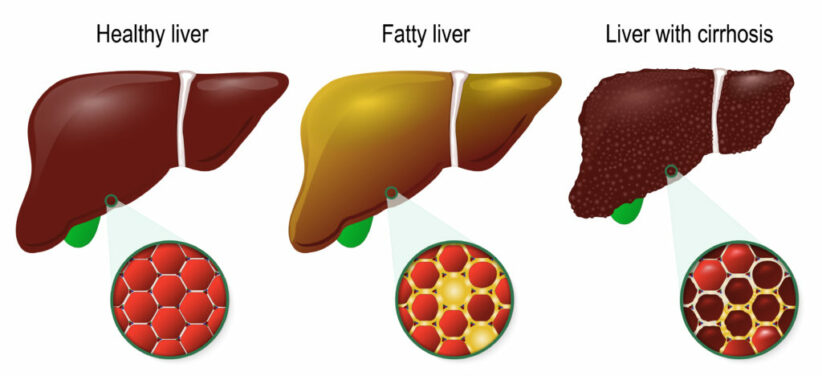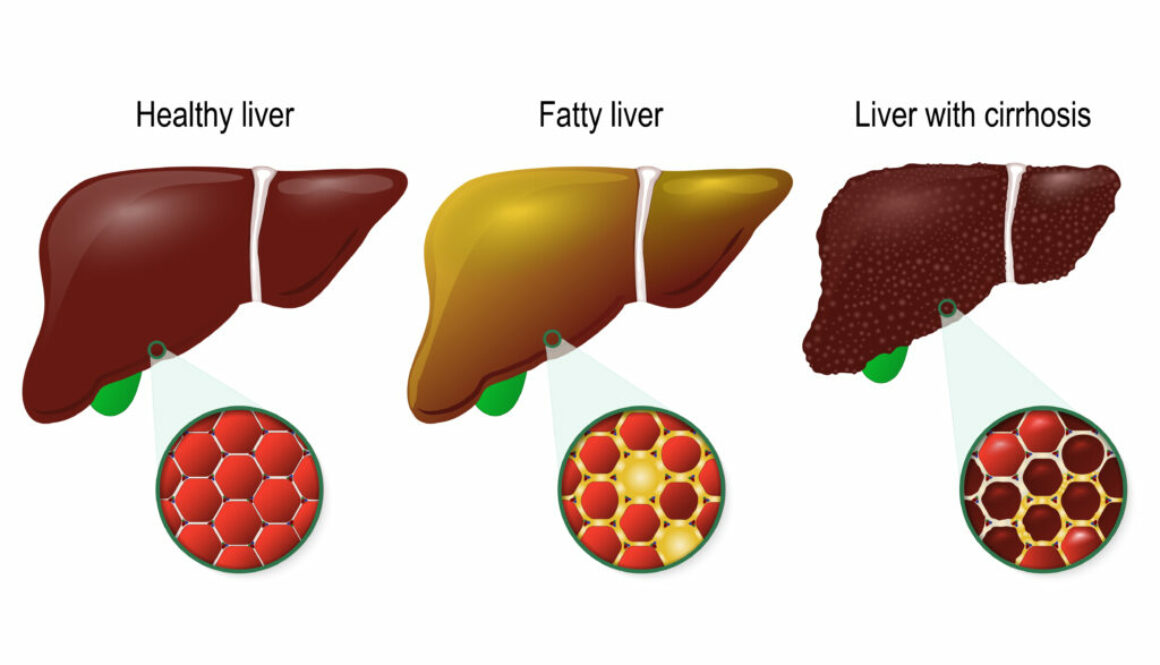Fatty Liver Disease Diagnosis and Treatment

FATTY LIVER DISEASE DIAGNOSIS & TREATMENT AT KENTUCKIANA INTEGRATIVE MEDICINE
Introduction: Over 80 million Americans Have NAFLD – Non-Alcoholic Fatty Liver Disease, but very few are aware of their condition because it is generally painless and without symptoms. It can be diagnosed as described below with lab testing and a formula. Definitive testing with a fiber scan is relatively inexpensive and requires a specialized ultrasound device. A biopsy can also be considered in advanced or uncertain cases. There is currently no officially FDA-approved medical treatment for fatty liver; however, there are helpful IV therapies, vitamins, and lifestyle changes that when implemented early enough can be of tremendous help.
At Kentuckiana Integrative Medicine, we assist patients using IV Alpha Lipoic Acid, IV Plaquex, Supportive Liver supplements, and Lifestyle Dietary changes with significant success.
NAFLD Non-Alcoholic Fatty Liver Disease
The spectrum of NAFLD Non-Alcoholic Fatty Liver Disease ranges from nonprogressive steatosis [liver fatty accumulation] to progressive conditions such as NASH – Non-Alcoholic steatohepatitis, fibrotic NASH, and end-stage NASH which is associated with liver cirrhosis and often liver cancer. NASH is a major cause of liver cancer. NAFLD is also strongly associated with Insulin Resistance, Type 2 Diabetes Mellitus, Blood Vessel Dysfunction, and Heart Disease.
The global prevalence of NAFLD is about 25% and the global presence of NASH is about 12% to 14%. However, a recent study found alarming data demonstrating that among patients in endocrine and primary care clinics, more than 70% of patients with type 2 diabetes and more than 90% with type 2 diabetes who had a body mass index (BMI) above 35 kg/m2 also had NAFLD, and more than 20% of those patients had significant liver fibrosis.
Unfortunately, very few people are aware they have either condition. The prevalence is extremely common and much like high blood pressure it is a silent killer. At least 80 million Americans have this but only about 6% know they have it. In fact, most cases of NAFLD are diagnosed incidentally when people undergo an ultrasound or a CT scan for another reason. In about 70% of cases, the liver enzymes are normal, and those patients rarely undergo liver workups.
Early Identification in Patients with NAFLD
In an editorial, Dr. Suthat Liangpunsakul, MD, writes: Early identification and risk stratification of patients with NAFLD, especially the degree of hepatic fibrosis, are required to reduce downstream healthcare costs and triage unwarranted specialty care referrals.” “An effective screening strategy [is needed] to identify those in primary care and endocrinology settings who may benefit from an appropriate referral to hepatologists BEFORE the development of portal hypertension complications, decompensated liver disease, and hepatocellular carcinoma”[liver cancer], added Liangpunsakul, professor of medicine in the Division of Gastroenterology and Hepatology at Indiana University School of Medicine, Indianapolis.
Screening for fatty Liver Disease Using the New FIB-4 Test is Recommended
The guideline calls for screening all patients at high risk for NAFLD, including those with prediabetes, type 2 diabetes, obesity, and/or two or more cardiometabolic risk factors, or those with hepatic steatosis found on imaging, and/or persistently elevated plasma aminotransferase levels (ie, for more than 6 months). The recommended screening test is the fibrosis-4 (FIB-4) index, calculated using the *patient’s age, *AST level, *platelet (PLT) count, and *ALT level:
FIB-4 score = age (years) x AST (U/L) / [PLT (109/L) x ALT ½ (U/L).
Recently approved by the US Food and Drug Administration (FDA), the FIB-4 has been demonstrated to help identify liver disease in primary care settings. The FIB-4 stratifies patients as being low, intermediate, or high risk for liver fibrosis. Those at low risk can be managed in primary care or endocrinology settings with a focus on obesity management and cardiovascular disease prevention. “Those at low risk on FIB-4 still have a high cardiovascular disease risk. They still need to be managed,” Isaacs observed.
For those at intermediate risk, a second noninvasive test — either a liver stiffness measurement by elastography or an enhanced liver fibrosis (ELF) test — is advised. If the patient is found to be at high risk or is still indeterminant after two non-invasive tests, referral to a liver specialist for further testing, including possible biopsy, is advised.
Those found to be at high risk with the FIB-4 should also be referred to hepatology. In both the intermediate- and high-risk groups, management should be multidisciplinary, including a hepatologist, endocrinologist, and other professionals to prevent both cardiovascular disease and progression to cirrhosis, the guidelines say.
NAFLD Treatment in Endocrinology and Primary Care: CVD Prevention
Dr. Kenneth Cusi, MD, chief of endocrinology, diabetes, and metabolism at the University of Florida, Gainesville, summarized current and future treatments for NAFLD as follows: Lifestyle intervention, cardiovascular reduction, and weight loss for those who are overweight or obese are recommended for all patients with NAFLD, including structured weight loss programs, anti-obesity medications, and possibly bariatric surgery if indicated.
There are currently no FDA-approved medications specifically for NASH, but pioglitazone, approved for type 2 diabetes, and glucagon-like peptide-1 (GLP-1) agonists, approved for type 2 diabetes and weight loss, have been shown to be effective in treating the condition and preventing progression. Other treatments are in development, Cusi said.
The guideline also includes a section on the diagnosis and management of NAFLD in children and adolescents. Here, the FIB-4 is not recommended because it isn’t accurate due to the age part of the equation, so liver enzyme tests are used in pediatric patients considered at high risk due to clinical factors. Management is similar to adults, except not all medications used in adults are approved for use in children.
Kentuckiana Integrative Medicine can help treat Non-Alcoholic Fatty Liver Disease. We have a team of experienced practitioners who can help you develop a treatment plan that’s right for you. Contact us today to schedule an appointment.
CONTRIBUTORS: Drs Isaacs and Liangpunsakul have reported no relevant financial relationships. Dr. Rafael F. Cruz is affiliated with Kentuckian Integrative Medicine.

